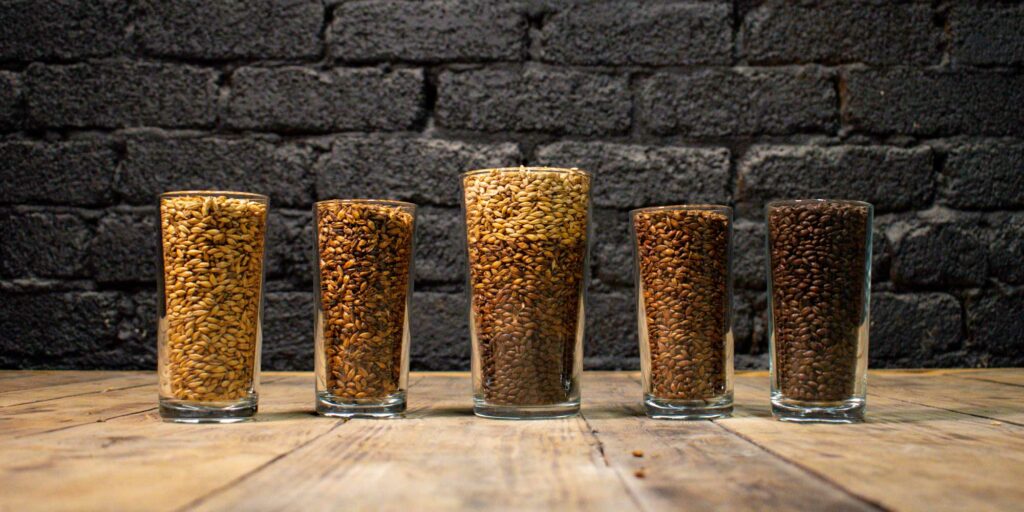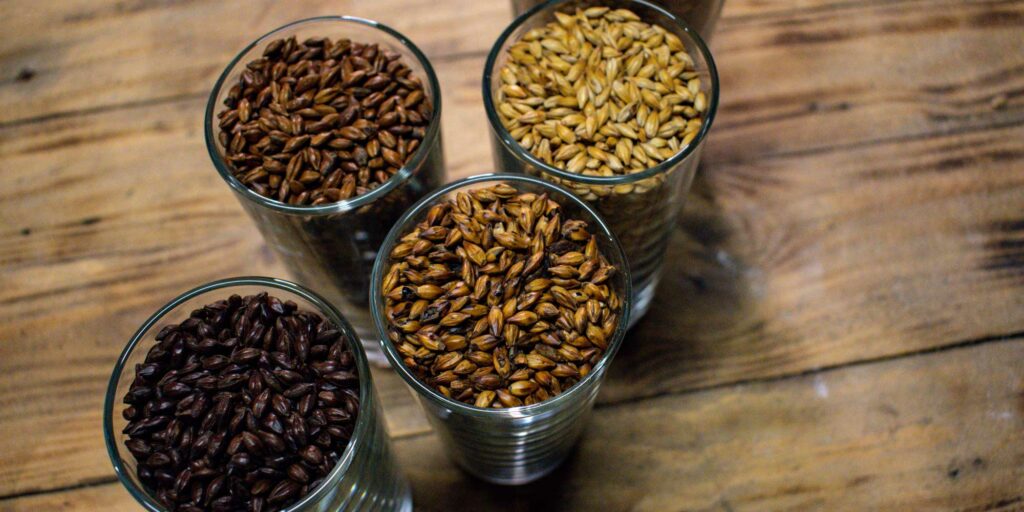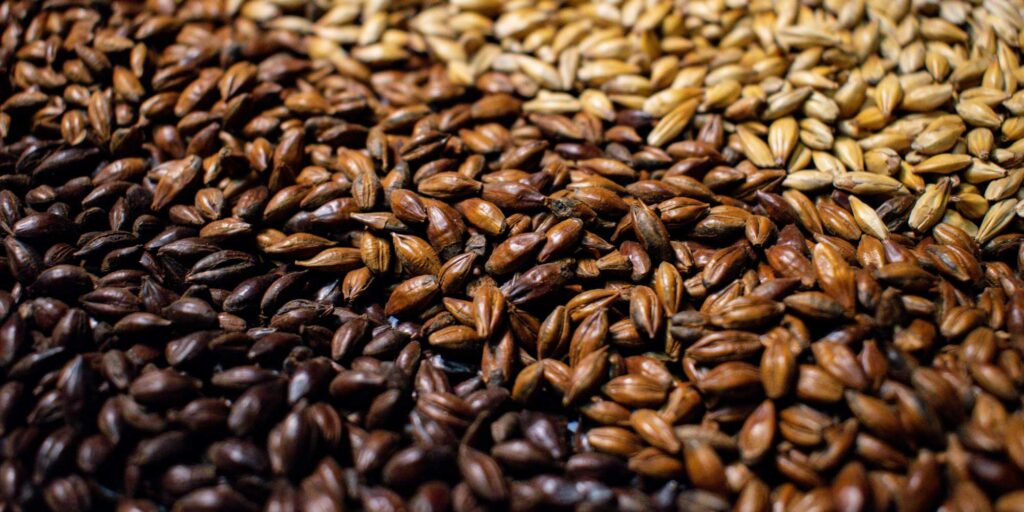
The foundation of most beers has to be malt. Malts make up a big part of a beer and they can make or break a brew. They are responsible for the fermentable sugars, some of the flavours and aromas, and the colour of our beer.
Consistency is the name of the game. If you are confident that your ingredients will produce consistent results, you’re on your way to making a perfect brew every time. Malts play an essential part in consistency in brewing. Your final ABV and EBC will all depend on your malts; if you are not using fresh quality grains, who knows what you will get in the end.
Our malt suppliers pride themselves on the excellence of their malts. Their process and procedures ensure they produce quality malts with consistent results. And our quick turnaround in stock ensures you always get the freshest malts. A factor we consider when choosing which malts we want to stock.
SO WHAT EXACTLY IS MALT?
The word malt possibly comes from the Germanic “maltam”, derived from “mel”, meaning soft; likely due to “softening” the grain for the malting process.
The grains used can vary, but most belong to the grass family. Western-style beer is typically made from barley. Grains like wheat, rice, millet, corn, and sorghum are also used worldwide.
These grains are basically seeds. These seeds start with a large amount of starch during their natural life cycle. The starch will become the fuel source for the next stage of development. When germination begins, enzymes are released that break down the starch (complex carbohydrates) into sugars, mainly maltose. These sugars give the seed the energy to grow and eventually become a new plant.
Maltose is a highly fermentable sugar, which means yeast loves it. This is good news for brewers.
Malting replicates this natural process. There are a few different methods to get germination going, but all have the same formula. Keeping them slightly moist, well ventilated and at a constant temperature (about 18’C) does the trick. Within a few days, the grains start producing roots and sprouting. The growing cycle must then be stopped before the seeds use all the sugar. Grains are then kilned, which will dry them and stop their growth.
The next step is to start bringing out flavours and colour to the malt. This is done by roasting, toasting or even smoking the malts. Different flavours and colours can be produced depending on how long this is done.

What comes next?
Once the grains have gone through the malting process, next comes brewing! Combining different malts and then boiling them will extract the sugars, flavours, and colours to make wort. This combination of malts is called a grain bill. The typical malts used are:
- Base malt
Most of the sugar comes from the base malt and will make up most of the grain bill. This malt usually has a low EBC and flavour. - Kilned Malt
These malts will bring loads of colours and flavours to the wort. The colour can vary dramatically, and you will get flavours like coffee, caramel and even burnt toast. - Crystal & Cara Malt
These malts are similar to the kilned malts but made slightly differently. They will also give some colour to beer with beautiful flavours.
THE MALT WORLD IS GETTING SMALLER
We have so many options readily available to us from all around the world. On top of this, we have the information at our fingertips like water profiles and brewing techniques. This means we can produce beers with authentic flavour profiles.
We have three different malts brands, giving you world-class malts to experiment with.
BRITISH / UK MALTS
- English Pale Malt: Full-bodied with a steady taste.
- English Crystal: Loads of colour and flavour with a toffee-sweet flavour and aroma. Suitable for bitters, pale ales, and porters.
- Chocolate Malt: A versatile malt with a smooth character and roasted flavour. Used for British porters, some brown to mild ales and more robust stouts.
- Brown Malt: This will give a roasted flavour and bitterness to beer. Used in traditional brown ale, stouts, and porters.
- Amber Malt: Gives warm and almost coffee-like taste. Superb in Scottish, pale and brown ales.
Click here to see our tour of Crisp Malts
BELGIAN
- Belgian Pilsner: Great for malty beers. Perfect in lagers, Belgian ales, and wheat beers.
- Aromatic: Ads in plenty of distinct flavour and rich colours. Great for ales and lagers.
- Belgian Special: It is a dark and complex malt known for its almost raisin-like flavours, with a robust roasted caramel colour and flavour. It can make beers appear ruby red to dark brown.
- Biscuit Malt: A pleasantly toasted malt. Great in lagers and ales. It will give a toasted bread flavour.
- CaraVienne: Light caramel sweet malt that will add a fuller beer flavour. With a beautiful caramel aroma, it won’t give your beer too much caramel flavour.
- CaraMunich: A caramelised German Munich malt known for its reddish colour, giving loads of taste and a rounder texture. Oktoberfest or speciality beers use this malt.
Click here to see our tour of Dingemans Malts
GERMAN
- German Pale Malt: Makes up a big part of wheat and Weizen beers. Full-flavoured recognisable in any wheat beer. Terrific for German yeast strains.
- Weizen: These are blended with pale malts and give a full flavour.
- Wiener/Vienna Malt: Will give a fuller, deeper malt flavour and aroma. Beers will be a light amber and will up the body in your beer.
- Munchener/ Munich Malt: A pale malt with plenty of enzymes to create a complete, malty flavour in your beer. The beers are golden in colour and lightly caramelised.
- Crystal / Med. Caramel: Will add colour and sweetness, gives plenty of body and sweetness to speciality beers.
- Carafa Special: Made by de-husking barley that helps reduce its harsher flavour and brings a roasted flavour.
- German Acidulated Malt: This has lactic acid bacteria used to adjust your beer’s pH levels.
- German Melanoidin: An aromatic and darker malt that gives reddish brown. It has a great body and fullness.
